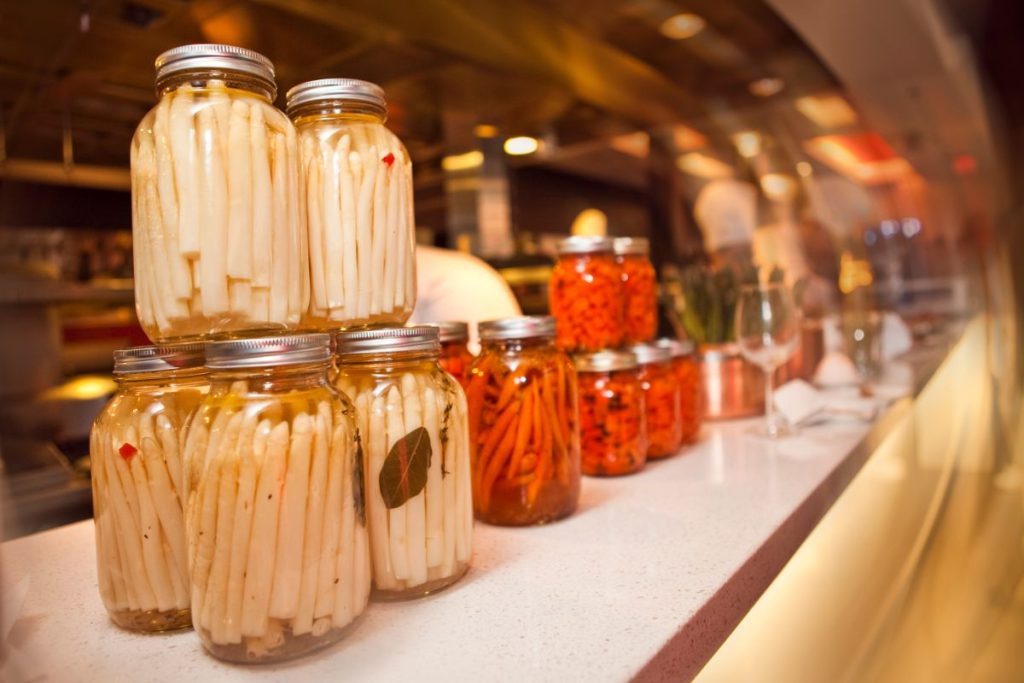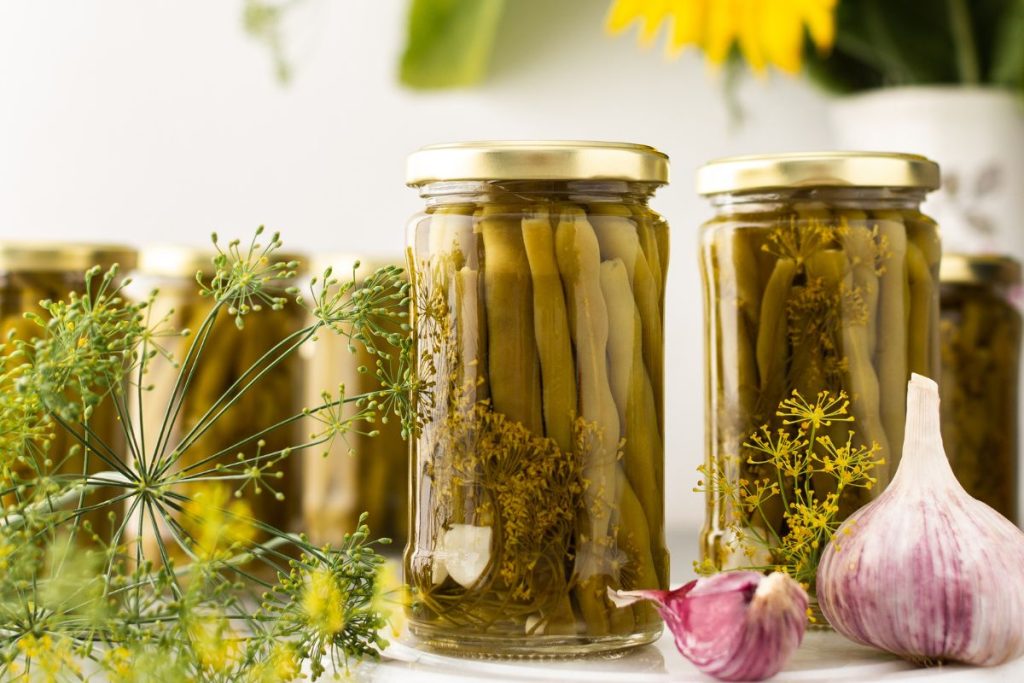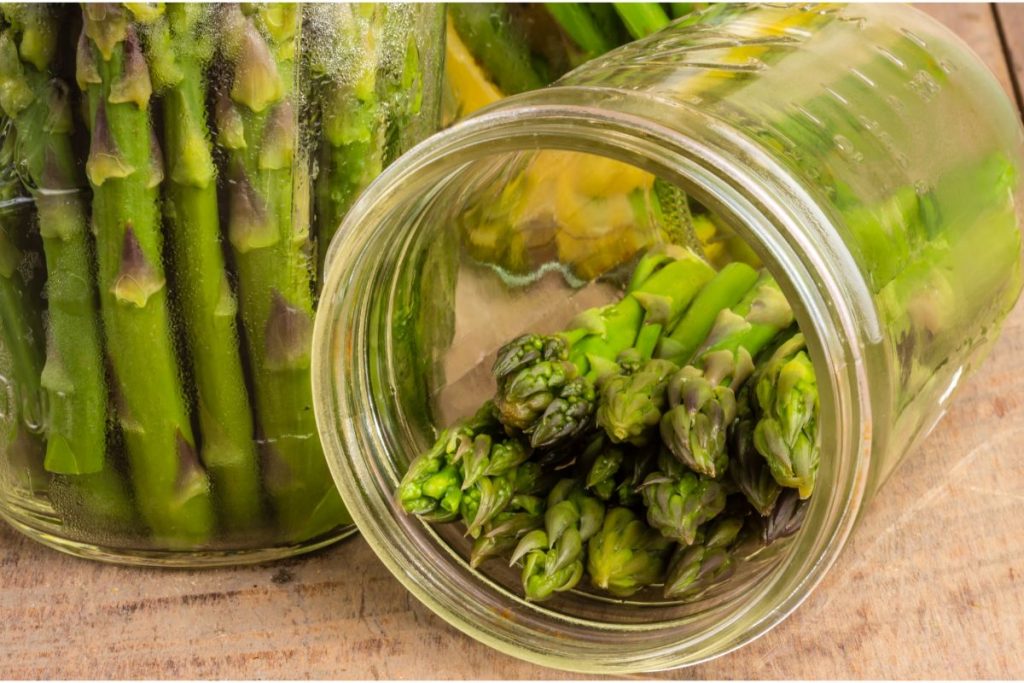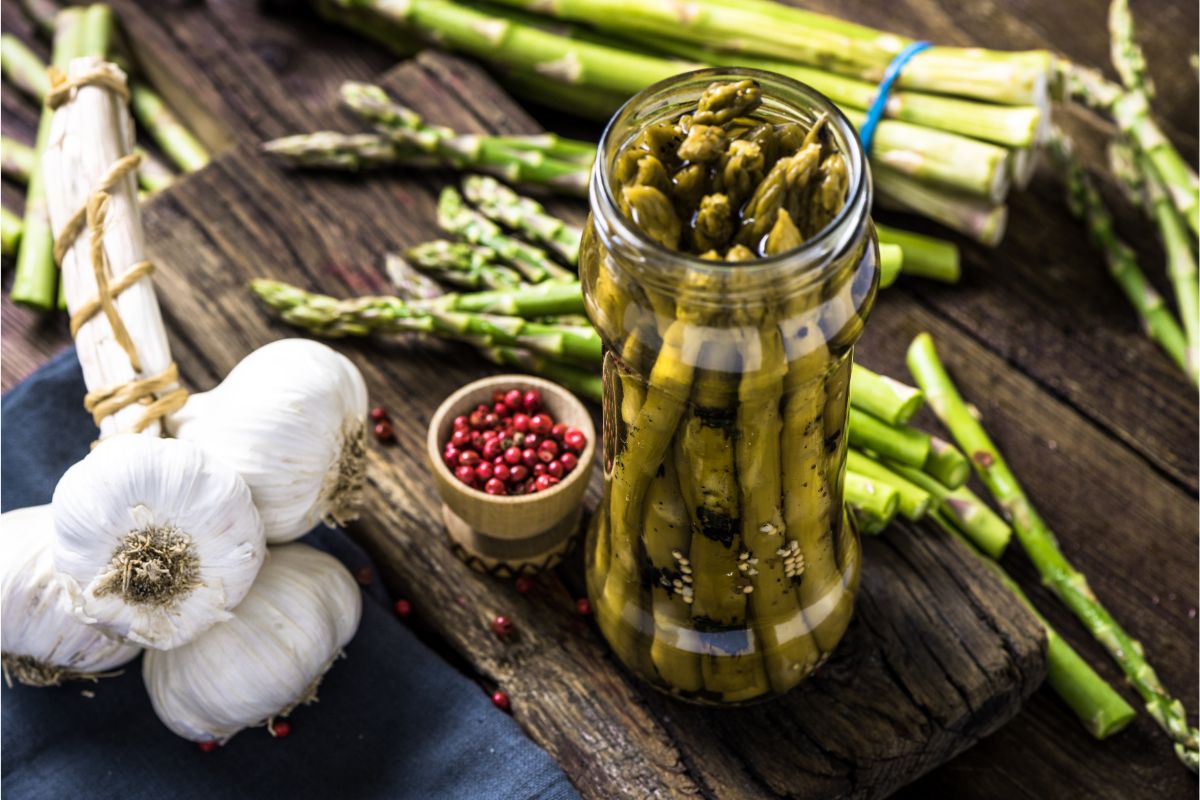Canning asparagus begins by trimming the spears and raw packing them into sterilized canning jars. Asparagus should be covered with boiling water or brine, leaving 1/2-inch headspace. Process jars in a pressure canner for 30-40 minutes per elevation.
How to Pickle Asparagus
Pickling asparagus or fermenting it is required before canning asparagus in a water bath. Low-acid veggies such as mustard greens and asparagus require acidification before canning if not canned in a pressure canner.
Follow these steps to pickle asparagus:
- Select fresh asparagus that is firm with straight stalks and tight tips.
- Thoroughly wash the asparagus under cold running water while snapping or trimming the tough ends off with a sharp knife.
- Blanch the asparagus in a pot of salted boiling water for 1-2 minutes until they slightly soften and become a vibrant green.
- Drain the blanching water and transfer the asparagus to a pot of cold water containing ice to stop the cooking process. Remove the stalks from the ice water after 5 minutes and set aside.
- In a large pot, combine water, sugar, canning salt, vinegar with at least 5% acidity, and other spices of your choice to create a pickling liquid. You can use garlic cloves, dill, crushed red pepper, or mustard seeds for additional flavor. At least half the brine mixture should consist of 5% vinegar. Boil the brine while stirring until the sugar dissolves.
- Pack asparagus into sterilized pint-sized canning jars.
- Cover the packed asparagus with the hot pickling liquid, leaving 1/2 inch headspace in each pint jar.
- Wipe the rims of the jars with a damp cloth.
- Seal the jars by applying new canning lids and add screw bands. Tighten until fingertip tight.
- Fill a boiling water bath canner halfway with water and bring to a rolling boil.
- Using a jar lifter or canning tongs, place the pickled asparagus onto the canning rack inside the canner. Ensure boiling water is at least 1 inch above the top of the canning jars.
- Close the lid on the canner and begin timing. Process the jars in the boiling water bath for 10-15 minutes, depending on your elevation. If you live below 1,000ft, process for 10 minutes, and if you live at 1,001ft and above, process for 15 minutes.
- When the recommended processing time is over, take the jars out of the canner using a jar lifter and sit them on a towel-covered countertop. Let them cool at room temperature for 12-24 hours.
- Remove the screw bands and check the seals to ensure the canning lids are indented. If the lids do not flex up and down, they are sealed.
- Store the canned, pickled asparagus in a cool, dark place away from humidity and direct sunlight. Allow them to sit for at least 7 days before using them for the best flavor.

Pressure Canning Asparagus Guide
The only safe way to can asparagus is in a pressure canner (if not pickling it). Asparagus is a low-acid food, and pressure canning reaches the recommended high heat temperature range of 240°F to 250°F recommended by the USDA for safe canning.
If canning for the first time, be sure to follow established canning recipes and canner load guidelines established by the National Center for Home Food Preservation. Use pint jars or quart jars made for high-pressure canning, such as Mason jars.
Follow these steps to pressure can asparagus:
- Wash the asparagus carefully with cold water and trim the ends. Cut the spears into lengths that can fit into the canning jars.
- Prepare the canning jars, lids, and bands by washing them with warm, soapy water and rinsing them well. Sterilize the jars in boiling water for 10 minutes and the lids and bands for 5 minutes.
- Bring a pot of water to a boil for blanching the asparagus and blanch for 1-2 minutes. Drain the hot water and quickly transfer the vegetables into a bowl containing cold water and ice cubes to end the cooking process.
- Take the asparagus out of the cold water after 5 minutes.
- Pack the asparagus into the sterilized canning jars. Add 1 tsp of canning salt to each jar before adding the asparagus spears (optional).
- Using a canning funnel, fill jars with boiling water to cover the asparagus, leaving 1-inch headspace.
- Remove air bubbles from the hot jars with a bubble remover tool.
- Wipe the rims of the jars using a damp cloth to remove food particles.
- Seal the jars with the sterilized lids and bands and tighten them by hand until fingertip tight.
- Follow the manufacturer’s instructions for your pressure canner model and preheat it with 2-4 inches of water. Add the canning rack to the bottom of the canner.
- Load the jars into the prepared pressure canner using a jar lifter and set them on the canning rack, ensuring none of the jars are touching.
- Close the lid of the pressure canner and allow it to vent steam for 10 minutes. Allow the pressure to climb to the appropriate pressure per your elevation, and process the jars for 30-40 minutes:
Processing time for raw pack or hot pack asparagus in a dial-gauge pressure canner:
| Altitude (ft) | 0 – 2,000 | 2,001 – 4,000 | 4,001 – 6,000 | 6,001 – 8,000 |
| Pints (30 mins) | 11lbs | 12lbs | 13lbs | 14lbs |
| Quarts (40 mins) | 11lbs | 12lbs | 13lbs | 14lbs |
Processing for raw pack or hot pack asparagus in a weighted-gauge pressure canner:
| Altitude (ft) | 0 – 1000 | 1,001 + |
| Pints (30 mins) | 10lbs | 15lbs |
| Quarts (40 mins) | 10lbs | 15lbs |
- Turn off the heat and allow the pressure canner to cool. Do not open the canner until the pressure reaches zero.
- Allow the jars to sit in the canner for another 5 minutes. Use a jar lifter to take the jars out of the canner and place them on a towel-covered surface to cool for 12-24 hours.
- Remove the screw bands from the jars and check the seals on the jars to ensure they don’t flex up and down.
- Store sealed jars in a cool, dry place. Reprocess any jars that didn’t seal using brand-new canning lids.

Can Asparagus Be Water Bath Canned?
It is not recommended to water bath can asparagus. Asparagus is a low-acid veggie that should be pressure canned to prevent the growth of harmful bacteria.
Water bath canning is suitable for high-acid foods such as pickles and fruits. Only use the boiling water bath method to can pickled asparagus, which is preserved with white vinegar or vinegar with at least 5% acidity.
Does Asparagus Need to be Blanched Before Canning?
Yes, blanching asparagus before canning is an important step. While blanching takes additional prep time, it preserves the texture, color, and flavor of the asparagus and also helps to reduce any bacteria that may be present.
Is Home Canned Asparagus Mushy?
Home-canned asparagus may be mushy if not canned properly. Over-blanching or over-processing the asparagus can make it mushy.
For best results, use fresh, high-quality asparagus, and add salt to the jars before canning. Pickling asparagus will result in a firmer texture, particularly when the brine is made with Pickle Crisp or similar products designed to help pickles retain a crisp texture.

What is the Shelf Life of Home Canned Asparagus?
Home canning asparagus makes it shelf stable and gives it a shelf life of 12 months when properly stored in a cool, dark, and dry place.
Pickled asparagus may also be stored in a refrigerator and used within 2 months if not processed in a canner. Do not store pickled asparagus that hasn’t been canned at room temperature.

